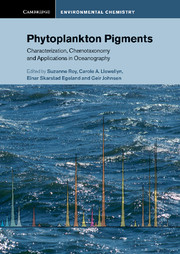Book contents
- Frontmatter
- Contents
- Contributors
- Preface
- Acknowledgements
- Abbreviations and symbols
- Part I Chlorophylls and carotenoids
- Part II Methodology guidance
- 4 New HPLC separation techniques
- 5 The importance of a quality assurance plan for method validation and minimizing uncertainties in the HPLC analysis of phytoplankton pigments
- 6 Quantitative interpretation of chemotaxonomic pigment data
- 7 Liquid chromatography-mass spectrometry for pigment analysis
- 8 Multivariate analysis of extracted pigments using spectrophotometric and spectrofluorometric methods
- Part III Water-soluble ‘pigments’
- Part IV Selected pigment applications in oceanography
- Part V Future perspectives
- Part VI Aids for practical laboratory work
- Part VII Data sheets aiding identification of phytoplankton carotenoids and chlorophylls
- Index
- Plate Section
- References
7 - Liquid chromatography-mass spectrometry for pigment analysis
Published online by Cambridge University Press: 05 March 2012
- Frontmatter
- Contents
- Contributors
- Preface
- Acknowledgements
- Abbreviations and symbols
- Part I Chlorophylls and carotenoids
- Part II Methodology guidance
- 4 New HPLC separation techniques
- 5 The importance of a quality assurance plan for method validation and minimizing uncertainties in the HPLC analysis of phytoplankton pigments
- 6 Quantitative interpretation of chemotaxonomic pigment data
- 7 Liquid chromatography-mass spectrometry for pigment analysis
- 8 Multivariate analysis of extracted pigments using spectrophotometric and spectrofluorometric methods
- Part III Water-soluble ‘pigments’
- Part IV Selected pigment applications in oceanography
- Part V Future perspectives
- Part VI Aids for practical laboratory work
- Part VII Data sheets aiding identification of phytoplankton carotenoids and chlorophylls
- Index
- Plate Section
- References
Summary
LC-MS analysis of chlorophylls and carotenoids: introduction
Because of improvements in HPLC methods for the analysis of phytoplankton pigments, pigments that are unidentified but spectrally related to known compounds are frequently reported in microalgal cultures as well as in natural distributions (Jeffrey and Wright, 1994; Vaulot et al., 1994; Garrido and Zapata, 1998; Airs et al., 2001a; Carreto et al., 2001; Zapata et al., 2004). Distinctions between common chlorophylls and carotenoids can be ascertained during HPLC from on-line UV/visible (UV/Vis) spectra, or co-elution with authentic standards. Several chlorophyll types however occur as suites of compounds. A diverse array of chlorophylls c have been observed in marine microalgal cultures as free acids or esterified by a range of non-polar groups (Garrido and Zapata, 1998; Garrido et al., 2000; Zapata et al., 2001, 2006). Photosynthetic bacteria belonging to the genera Chlorobiaceae produce suites of bacteriochlorophylls differing both in the degree of alkylation at positions C-8 and/or C-12 (Smith and Bobe, 1987; Airs and Keely, 2002), and/or the alcohol esterified to the propionic acid group at C-17 (Caple et al., 1978; Otte et al., 1993; Airs et al., 2001b). Furthermore, chlorophyll a undergoes a range of transformation and alteration reactions when the phytoplankton cell is compromised and as detrital material is transported through the water column; these reactions are potentially indicative of specific environmental conditions or processes (Head and Horne, 1993; Head et al., 1994; Veldhuis et al., 2001; Walker and Keely, 2004). Several carotenoid types also exist as suites of compounds, for example fucoxanthin esters (Airs and Llewellyn, 2006). Characterisation of novel compounds involves rigorous chemical and analytical techniques following preparative isolation of individual components (Egeland et al., 2000). Such an approach can be impractical when unknowns are present in low relative abundance. Liquid chromatography-mass spectrometry (LC-MS) permits acquisition of structural data during a single chromatographic run. Molecular mass information, used in conjunction with PDA UV/vis spectra is often sufficient for the assignment of components. HPLC coupled to tandem MS (LC-tandem MS) adds a further dimension and can be used to identify structural differences that do not affect the UV/Vis absorption properties, or to distinguish ions with the same mass-to-charge ratio (isobaric ions). Furthermore, LC-tandem MS is particularly powerful if MS/MS spectra of an unknown compound are compared with a structurally related, identified compound.
- Type
- Chapter
- Information
- Phytoplankton PigmentsCharacterization, Chemotaxonomy and Applications in Oceanography, pp. 314 - 342Publisher: Cambridge University PressPrint publication year: 2011
References
- 5
- Cited by



